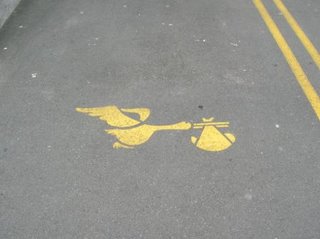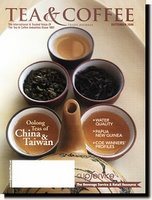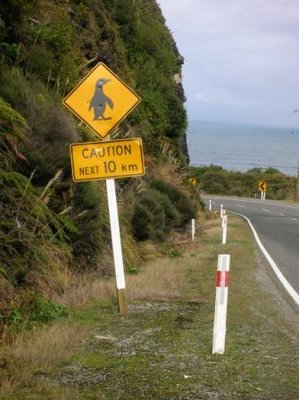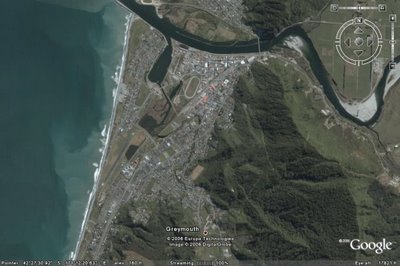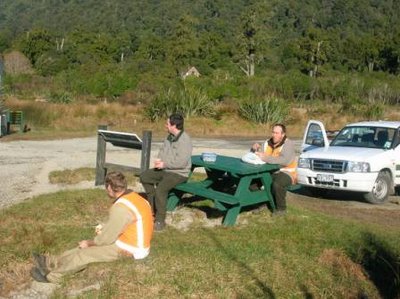On billboards, helicopters and sphagnum moss
Standing at my bus stop in

Gratuitous and unrelated photo of
It's beautiful, eh? This is a creek near Oparara Arches at the northern end of the West Coast.
And I watched with interest as the billboard over my bus stop was routinely changed every few months. Somehow before that I thought that billboards were painted on or pasted up like wallpaper, but here at least they seemed to be some large pre-printed canvas stretched and clipped over the corners of the frame. Sometimes there were tidbits that had to hang over the edges, a giraffe’s neck stretched up above the top of the frame, or an umbrella poking out beyond the edges. These required extensions to be added onto the framing, so I'd see the crew up on scaffolding around the billboard working their magic.
The hanging of billboards was done in relative obscurity. Just a regular part of the city’s morning routines – the garbage being collected, people collecting cans from the recycle bins left at the curb, storefront sidewalks getting swept, people lining up for their morning coffee fix. About the only time I even consciously thought about billboards was when some friends were in one that we produced at my old job - pick up the poop, for all you dog walkers out there.

Recently our billboard (I think there's only one here in Greymouth) changed and it was front page news in the local paper. I admit to a discreet smile over this fact. How 'small town', I thought. It’s hard not to make comparisons – that’s part of the fun of moving overseas, experiencing new places. Thinking back on how routine billboard changes felt in
The billboard that was being replaced was an image of some coal miners decked out in their helmets and other gear, a few coal smudges here and there, with a pitch for how the coal company is part of the community. I’d noticed it before. I would have guessed the photo was staged, with models. It was an advertisement after all. But it turns out they were real miners in the photo, as the article discussed how this was the end of their high profile existence. It listed each of them by name and in which mines they worked. I didn't know any of them, but certainly others in town must. They were famous apparently.
Well, the new ad is by the same coal company featuring the rescue helicopter they sponsor here in town. The new advertisement was in honor of rescue helicopter awareness month. In fact, this weekend they're having an open house to kick off the month. Stop by, if you're in town.
Now I didn't know there was such a month - but I must say that on the coast here helicopters are a critical part of the infrastructure. If cities are indeed living breathing creatures, then in Greymouth choppers take their turns as muscle, adrenalin and red blood cells, keeping things alive here. There aren’t that many things in the air at this edge of the island on the edge of the earth, so I notice whenever anything flies over head.
There’s a daily flight in and out to
Not too long ago one the pilots, Paul, hit an overhead cable when assisting with a police search of the coastline for the body of someone who had gone missing. He ended up with a bit of cable in his spine, but maneuvered the helicopter to a safe landing spot above the rocky shore before the crash. Everyone survived, but he was in the hospital for some time. His recovery and the investigation about the accident was a frequent discussion around the smoko table at work.
Following that incident, Paul was required to provide a refresher safety briefing for some of his regular customers – including us. So our whole crew went out there one day for an hour-long inspection, safety briefing and tour of his new helicopter. Every mistake these pilots make is dissected and discussed, as
What I found most interesting that day, however, had nothing to do with helicopters. It was a story Paul’s father told during the special smoko feast they served after the safety orientation. One of his new ventures, now that he had handed the piloting over to his son, is growing, harvesting and drying sphagnum moss. Others in the world do this as well, primarily for the horticultural market. Think hanging flower baskets. But he's arranged to be the exclusive supplier for a US-based entrepreneur who is developing new markets for our local moss which apparently has a unique bacteria or something in it. This American businessman is working to patent a new eco-friendly product which will use a dried derivative of our moss as a non-toxic replacement for chlorine in pool filtration systems. This is going to revolutionize swimming pools. There are also some medical applications in wound care that will reduce the use of toxics in the medical industry. I forget the details on this one, but that's to hit the market in the next few years as well.
Paul and his father aren’t on the new billboard. They're not getting that sort of high profile exposure. Yet in hearing these stories, Greymouth didn’t seem so disconnected from the world. Small town? Definitely. It may be far from big city life here, but it isn’t as isolated as I would have thought.











